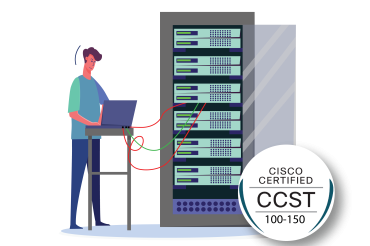Description
📅 Cisco Certified Support Technician (CCST)
🗓️ Duration: 1/2 Months
📚 Schedule: 5 Days Per Week
🕒 Session Length: 60 Minutes
💡 Total Sessions 30
📍for Learners in Afghanistan
🎯 Goal: Foundational knowledge → hands-on skills → career-ready
Course content
Identify the fundamental conceptual building blocks of networks.
TCP/IP model, OSI model, frames and packets, addressing
Differentiate between bandwidth and throughput.
Latency, delay, speed test vs. Iperf
Differentiate between LAN, WAN, MAN, CAN, PAN, and WLAN.
Identify and illustrate common physical and logical network topologies.
Compare and contrast cloud and on-premises applications and services.
Public, private, hybrid, SaaS, PaaS, IaaS, remote work/hybrid work
Describe common network applications and protocols.
TCP vs. UDP (connection-oriented vs. connectionless), FTP, SFTP, TFTP, HTTP, HTTPS,
DHCP, DNS, ICMP, NTP
Compare and contrast private addresses and public addresses.
Address classes, NAT concepts
Identify IPv4 addresses and subnet formats.
Subnet concepts, Subnet Calculator, slash notation, and subnet mask; broadcast domain
Identify IPv6 addresses and prefix formats.
Types of addresses, prefix concepts
Review quiz
Identify cables and connectors commonly used in local area networks.
Cable types: fiber, copper, twisted pair; Connector types: coax, RJ-45, RJ-11, fiber
connector types
Differentiate between Wi-Fi, cellular, and wired network technologies.
Copper, including sources of interference; fiber; wireless, including 802.11 (unlicensed,
2.4GHz, 5GHz, 6GHz), cellular (licensed), sources of interference
Describe endpoint devices.
Internet of Things (IoT) devices, computers, mobile devices, IP Phone, printer, server
Demonstrate how to set up and check network connectivity on Windows, Linux, Mac OS,
Android, and Apple iOS.
Networking utilities on Windows, Linux, Android, and Apple operating systems; how to run
troubleshooting commands; wireless client settings (SSID, authentication, WPA mode)
Identify the status lights on a Cisco device when given instruction by an engineer.
Link light color and status (blinking or solid)
Use a network diagram provided by an engineer to attach the appropriate cables.
Patch cables, switches and routers, small topologies, power, rack layout
Identify the various ports on network devices.
Console port, serial port, fiber port, Ethernet ports, SFPs, USB port, PoE
Explain basic routing concepts.
Default gateway, layer 2 vs. layer 3 switches, local network vs. remote network
Explain basic switching concepts.
MAC address tables, MAC address filtering, VLAN
Demonstrate effective troubleshooting methodologies and help desk best practices, including
ticketing, documentation, and information gathering.
Policies and procedures, accurate and complete documentation, prioritization
Perform a packet capture with Wireshark and save it to a file.
Purpose of using a packet analyzer, saving and opening a .pcap file
Run basic diagnostic commands and interpret the results.
ping, ipconfig/ifconfig/ip, tracert/traceroute, nslookup; recognize how firewalls can
influence the result
Differentiate between different ways to access and collect data about network devices.
Remote access (RDP, SSH, telnet), VPN, terminal emulators, Console, Network
Management Systems, cloud-managed network (Meraki), scripts
Run basic show commands on a Cisco network device.
show run, show cdp neighbors, show ip interface brief, show ip route, show version, show
inventory, show switch, show mac address-table, show interface, show interface x, show
interface status; privilege levels; command help and auto-complete
Describe how firewalls operate to filter traffic.
Firewalls (blocked ports and protocols); rules deny or permit access
Describe foundational security concepts.
Confidentiality, integrity, and availability (CIA); authentication, authorization, and
accounting (AAA); Multifactor Authentication (MFA); encryption, certificates, and
password complexity; identity stores/databases (Active Directory); threats and
vulnerabilities; spam, phishing, malware, and denial of service
Configure basic wireless security on a home router (WPAx).
WPA, WPA2, WPA3; choosing between Personal and Enterprise; wireless security concepts


